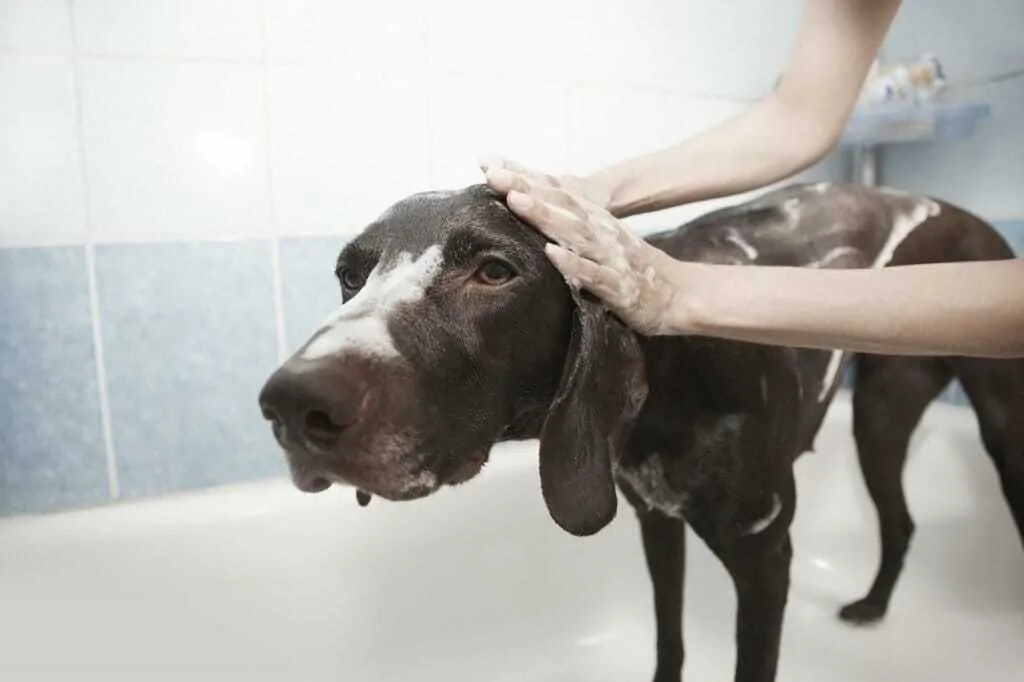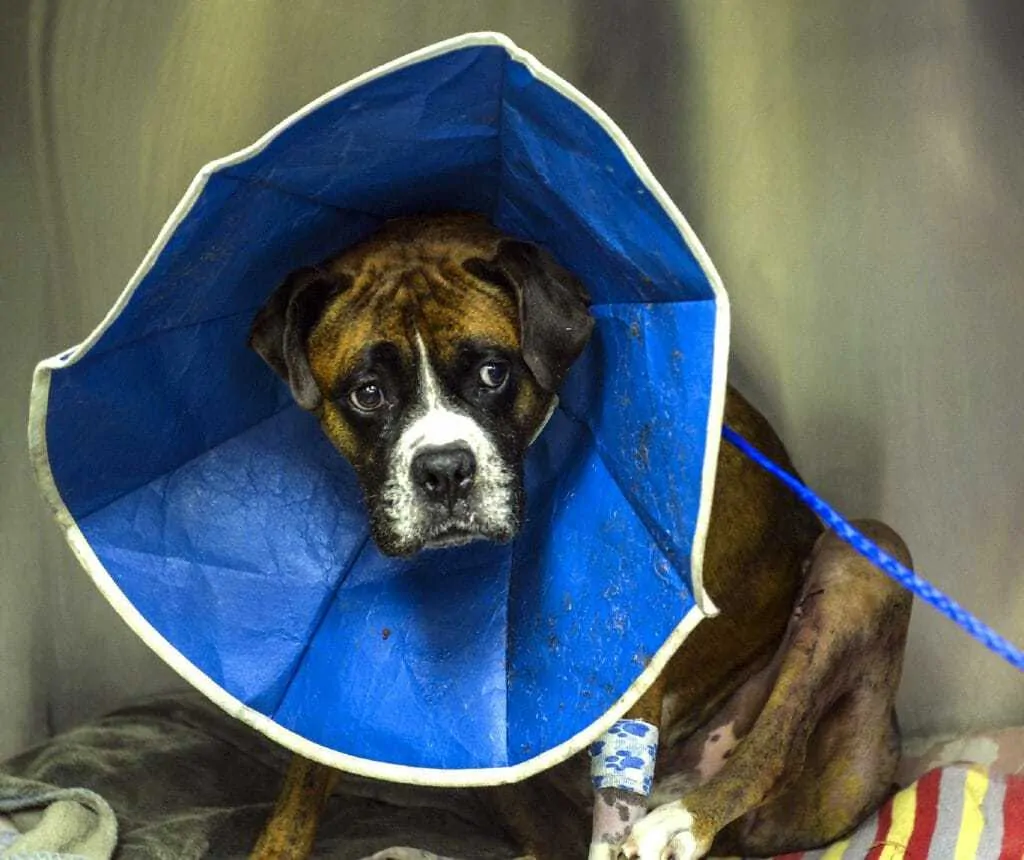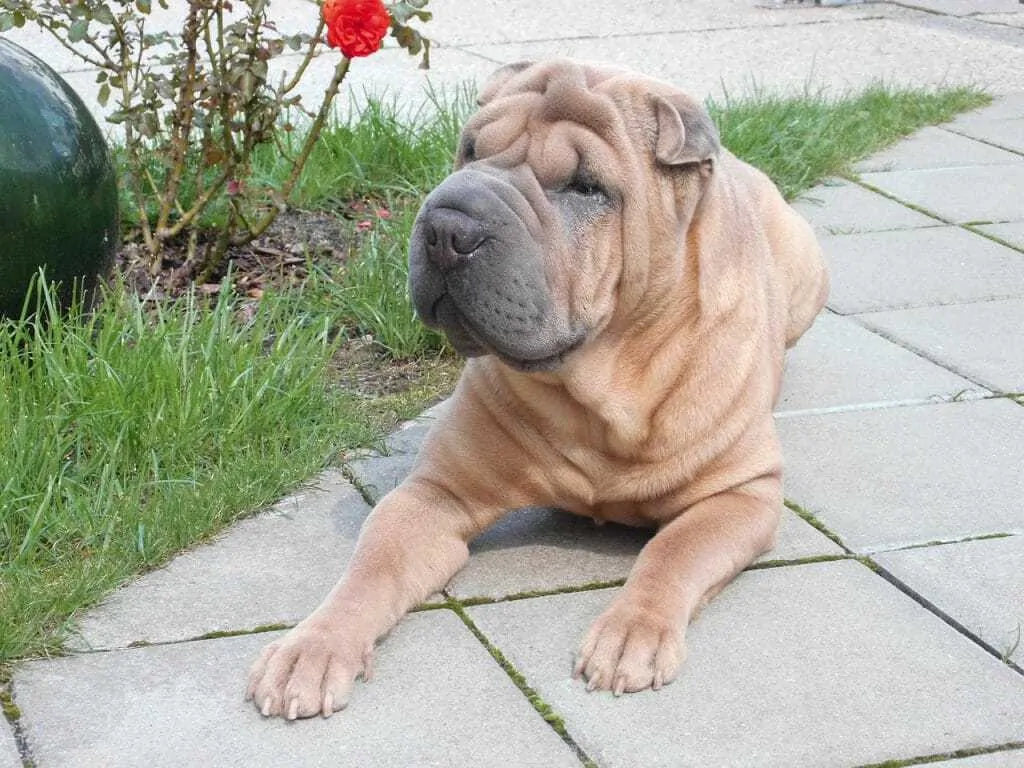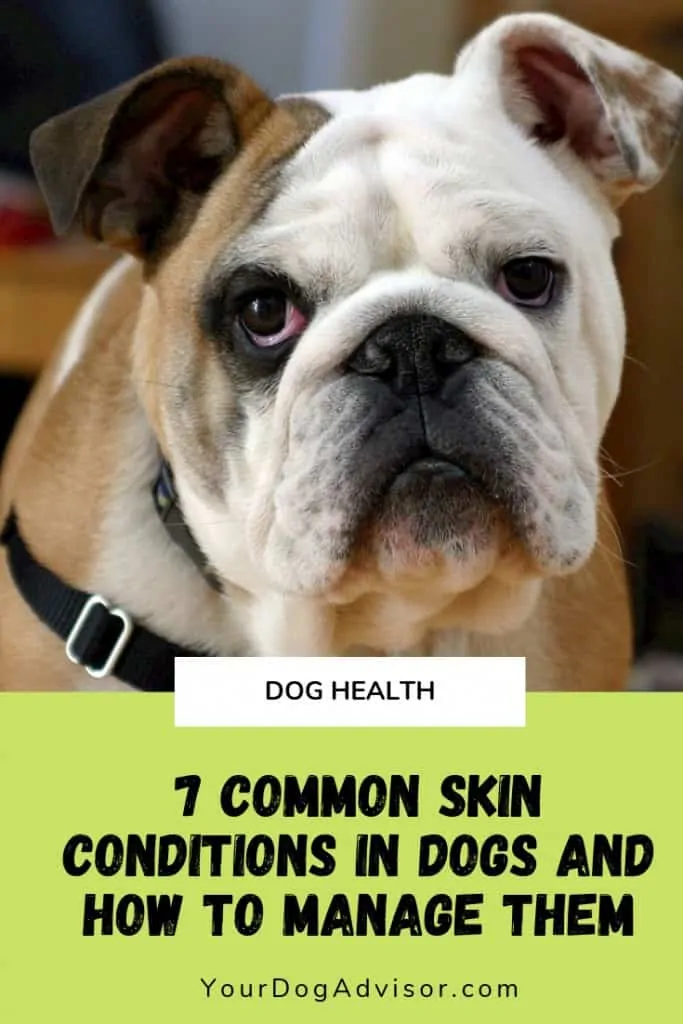There are few issues that plague dogs (and their caretakers) more persistently than problems with the skin. Although some breeds are more prone to skin problems than others (my shih-tzu, for example), all dogs are susceptible to a wide array of skin conditions ranging from a simple flea allergy to a full-fledged case of sarcoptic mange. And while diagnosing skin disease is best left to your vet, it’s helpful for you to have a working knowledge of the most common skin problems in dogs and how to manage them at home.
The overarching term for most dog skin problems is “dermatitis.” As is the case with humans, it can stem from a variety of causes, including allergic reactions, trauma, parasites (think fleas, ticks and mites) or infection. Some of these have distinct features. But many skin problems look similar, and it may take a bit of detective work on the part of you and your vet to get to the bottom of what’s bothering your pooch. Meanwhile, your goal will be to keep him as comfortable as possible and control symptoms as best you can.
Here is a rundown on some of the most common dog skin problems you may encounter and what you can do about each one.
Contents
No. 1 Atopic Dermatitis (Canine Eczema)
One of the most commonly encountered skin problems in dogs, canine atopic dermatitis (CAD) is a chronic condition that generally starts at about 6 months to one year of age. Also known as canine eczema, it’s closely associated with allergies, although it’s often difficult to pinpoint exactly what substance triggers the allergic response. Like humans with eczema, dogs with CAD have elevated blood levels of a substance called immunoglobulin E (IgE), a protein that helps the body mount an immune response. According to the National Eczema Association, researchers think excess IgE may be responsible for the dog’s hypersensitivity to normally harmless substances in his environment.
Any dog can develop atopic dermatitis, but some dogs breeds appear to be predisposed to the disease. These include:
- West Highland white terriers (and other terriers breeds)
- Golden Retrievers
- Labrador Retrievers
- Bulldogs
Bulldogs are prone to a number of hereditary issues, including atopic dermatitis.
The hallmark signs of atopic dermatitis are red, irritated skin and severe itching. Your dog may lick, chew, rub or bite the affected areas to the point that they are red, raw or even bleeding. In extreme cases, this persistent chewing can lead to oozing, open sores that become infected with bacteria. Your vet may refer to this as “moist dermatitis” or “wet eczema.” But most lay people call these sores “hot spots.”
Although atopic dermatitis can occur anywhere on your dog’s body, the most commonly affected areas are the:
- Ears
- Underarms
- Groin
- Wrists and ankles
- Muzzle
- Feet (especially between the toes)
As the condition becomes more chronic, you may also notice your dog’s skin feels thicker and rougher to the touch.
Management of Atopic Dermatitis
If your dog has recently been diagnosed with atopic dermatitis, your vet may suggest allergy testing to see if a specific trigger can be identified. If it is, you may wish to try “hyposensitization” therapy, which involves giving the dog regular injections of the offending substance(s) every few weeks for a period of up to a year. According to PetMD, this approach successfully reduces itching in about 60 to 80 percent of dogs. However, it can be quite expensive, and the results are not guaranteed.
Further, in many cases of CAD, a specific trigger can’t be identified. These dogs will require symptomatic treatment, most likely for the remainder of their lives. Fortunately, many cases of atopic dermatitis are seasonal, and symptoms typically wax and wane throughout the year.
So what can you do to help your poor itchy dog? Here are some ideas.
Regular Bathing
Regularly bathing your dog is a great way to remove potential irritants, such as pollen, dander, and other environmental pollutants, from her skin. To start, try an oatmeal-based, hypoallergenic shampoo, such as Earthbath Oatmeal and Aloe Shampoo. (Aloe vera also helps soothe the skin.) If that doesn’t provide enough relief, you may wish to try a shampoo that also contains tea tree oil, such as Vet’s Best Allergy Relief Shampoo. You can also make a soothing bath yourself by mixing one cup of ground oatmeal in some warm bath water and let your dog soak for a while. You can also add a little baking soda to increase the soothing effect.
Bathing your dog with a soothing shampoo containing oatmeal, aloe or tea tree oil may help soothe her itchy skin.
Topical Treatments
A number of over-the-counter topical solutions are available that may provide relief from dry, flaky, itchy skin. I use Espree Tea Tree and Aloe Medicated Spray when my dog’s CAD flares up, but almost any topical spray that contains tea tree oil will do. Vitamin E oil or a 50/50 solution of apple cider vinegar and water applied directly to the affected area may also have a soothing effect.
Diet
With the recent controversy over diet-associated dilated cardiomyopathy thus far unresolved, choosing a diet for your dog can be challenging, at best. My advice: Unless your vet has identified a specific food as the cause of your dog’s symptoms, don’t change her diet unless you have talked to a pet nutritionist and your vet.
That said, certain supplements have been shown to help maintain healthy skin and coat, and may provide some relief. These include:
- Fish oil supplements (Omega fatty acids)
- Brewer’s yeast
- Probiotics
- Evening primrose oil
The “Cone of Shame”
Although most of us want to avoid putting a cone on our dog, if your dog is licking and biting himself excessively you may have little choice. It won’t stop the itching, of course. But it can prevent your dog from injuring himself when you can’t be with him, or while you’re asleep. As most vets will tell you, a small sore can turn into an ugly, painful hot spot overnight.
A soft Elizabethan collar can prevent your dog with atopic dermatitis from harming himself when you aren’t around.
If your dog is chewing or licking his forelegs or torso, you can also try dressing him in a T-shirt rather than resorting to a cone. I’ve done this with my dog on occasion. And though it’s far from a perfect solution, it has helped.
Medications
If your dog’s symptoms are severe, your vet may prescribe medication to suppress the inflammatory response. According to the SkinVet Clinic these may include a corticosteroids such as prednisone or one of two non-steroidal drugs currently approved to treat CAD, Apoquel and Atopica. Over-the-counter antihistamines such as diphenhydramine (Benadryl) may also help.
Your dog should also be on year-round flea protection, since dogs with atopic dermatitis often have a severe reaction to flea bites.
No. 2 Canine Seborrhea
Like atopic dermatitis, seborrhea is a chronic condition that causes flaky, itchy skin. It occurs in two forms: oily seborrhea (seborrhea oleosa) and dry seborrhea (seborrhea sicca), but most dogs with the condition have a combination of the two.
Dogs with seborrhea produce an excess of sebum, an oily substance secreted by the sebaceous glands. According to Dr. James W. Randolph of My Pet Doctor.com, this waxy substance turns rancid very easily and quickly begins to smell. This accounts for the “rancid fat” smell many owners of dogs with seborrhea report. The dog’s skin may also have an oily, greasy feel.
In addition to excess oil production, seborrhea is characterized by rapid turnover of skin cells. Normally, mature skin cells form a protective layer on your dog’s skin until they die off after about 30 days. But in dogs with seborrhea, skin cells are shed before they fully mature. These immature skin cells form scales that look like dandruff, which may adhere to your dog’s fur or show up on his bed.The dog’s skin may also appear red and irritated, especially in the folds of the neck, armpits, feet, and legs. Crusty patches on the scalp, elbows or around the eyes, and a waxy, smelly build-up in his ears are also common in seborrheic dogs.
Causes of Seborrhea
Canine seborrhea can be either idiopathic (the cause is unknown) or secondary to another condition, such as allergies, hormone imbalances, parasites, infections, or dietary deficiencies. Your vet will perform tests to try to determine the underlying cause. If no cause can be identified, a diagnosis of idiopathic or “primary” seborrhea is made.
Primary seborrhea is more common in certain dog breeds, including:
- West Highland white terrier
- Basset hound
- Cocker spaniel
- Doberman pinscher
- German shepherd
- Golden retriever
- Labrador retriever
- Shar-pei
- Springer spaniel
In part due to its many skin folds, the shar-pei is one dog breed that develops seborrhea easily.
Management of Seborrhea
Sadly, primary seborrhea is not a curable condition, although symptoms can usually be managed with appropriate care. In dogs with secondary seborrhea, treating the underlying condition may improve symptoms. But since many conditions that make your dog susceptible to seborrhea are chronic, symptoms may recur.
That said, here are several things you can do as a caretaker to help keep your seborrheic dog comfortable and odor free.
Frequent Baths
When your dog has seborrhea, frequent bathing is an absolute must. Bathing “degreases” the skin and helps control odor, which can be very strong. Don’t be concerned about bathing your dog too frequently. If he smells bad, he needs a bath, for your sake as well as his own. Many dogs need to be bathed two to three times a week initially and then weekly once symptoms subside.
According to PetMD, shampoos containing coal tar, salicylic acid, benzoyl peroxide or sulfur are good choices for seborrheic dogs. However, since fungal or bacterial skin infections are common in dogs with this condition, your vet may recommend bathing him with an antifungal/antibacterial shampoo such as Malaseb. Whatever shampoo you choose, follow the directions carefully: Most of them need to be left on the skin for 5 to 10 minutes in order to work as they should.
Remember, too, that your dog should be dried thoroughly after his bath. Leaving his skin wet creates an environment where bacteria and fungi grow extraordinarily well.
Regular Grooming
If your dog has a long coat, keeping him well-groomed is another way to control some of seborrhea’s more troublesome symptoms. Pay particular attention to the skin folds under his neck and legs, behind his ears, and in his groin — all areas where excess oil tends to accumulate. Clean his ears at least weekly with a specially formulated ear cleaner for dogs. Epi-Otic Advanced by Virbac, which contains 0.2 percent salicylic acid, is one good choice, though your vet may have another brand he prefers.
Regular trips to the groomer can help keep your dogs symptoms under control, especially if she has long, thick fur.
Dietary Supplements
Since allergies may be a trigger for seborrhea, your vet may suggest that you modify your dog’s diet to limit the ingredients to which he’s exposed. Additionally, many dogs with seborrhea will benefit from supplements containing essential fatty acids, especially the Omega 3 fatty acids eicosapentaenoic acid (EPA) and docosahexaenoic acid (DHA). Most salmon and fish oil supplements contain adequate amounts of both of these.
No. 3 Yeast (Fungal) Dermatitis
Another very common skin problem in dogs, yeast dermatitis is a fungal infection of the skin. According to VCA hospitals, it’s caused by the organism Malassezia pachydermatis, which is normally present in small amounts on all dogs’ skin. Under some circumstances, however, the number of these organisms multiplies, and an actual infectious process begins.
Yeast dermatitis is typically referred to as an “opportunistic” infection, which means that conditions in either the external environment or within your dog’s body give the infection an opportunity to take hold. One of the most common culprits in this process is excess oiliness of the skin, which is why dogs with seborrhea are prone to developing infections caused by yeast. Dogs who are on immunosuppressive therapy (steroids, cancer drugs) are also more at risk.
Yeast also likes a warm, moist environment, so dogs who live in hot, humid climates and dogs with lots of skin folds tend to have more problems with yeast.
Yeast infections are more common in certain breeds of dog, including:
- West Highland white terrier
- Australian terrier
- Silky terrier
- Lhasa apso
- Basset hound
- Maltese
- Cocker spaniel
- Poodle
- Chihuahua
- Daschund
With it’s long hair and dense undercoat, the lhasa apso is prone to a number of skin issues, including yeast infections. Regular grooming, bathing and brushing are a must for this breed.
Symptoms of Yeast Infection
The symptoms of yeast dermatitis are similar to those of many skin diseases, and include:
- Redness
- Itchiness
- Flakiness, scaliness
- A strong, “musty” odor, especially in the ears
To make a diagnosis, your vet will take a sample of some skin cells and look at them under a microscope to check for the presence of yeast.
Treatment of Yeast Dermatitis
Most cases of yeast dermatitis can be managed with topical treatment. In some dogs, bathing with an antiseborrheic shampoo to remove excess skin oils may be the first step in the process, followed by regular baths with a medicated shampoo. Your vet will most likely recommend a shampoo containing chlorhexidine, a disinfectant, and either miconazole or ketoconazole (medications that control yeast.) If the infection is persistent or severe, she may also prescribe oral antifungal medications, which are usually given for a period of several months. Because these medicines can be toxic to the liver, your dog will need frequent blood tests during this time.
No. 4 Ringworm
Despite its name, ringworm is not a “worm” at all, but an infection caused by several species of fungus. In dogs, the most common culprit is the fungus Microsporum canis, which is responsible for about 70 percent of infections, according to the American Kennel Club. Microsporum canis is also responsible for about 90 percent of ringworm in cats. The spores live in the uppermost layer of skin and invade the hair follicles, causing the hair to become brittle and fall out.
Ringworm got its name from the red, wormlike rash that appears on the skin of humans affected by the disease. However, this presentation is not typical in dogs. Dogs with ringworm generally develop red, round, hairless lesions on various parts of the body that form scabs as they begin to heal. These lesions usually don’t itch.
Ringworm isn’t a serious infection, but it is very contagious. Prompt treatment is necessary to prevent the infection from spreading to other pets in the household or to humans who come in contact with your dog. Once your vet has confirmed the diagnosis, she will recommend topical treatment — usually an antifungal shampoo and perhaps an antifungal cream. To completely eradicate the fungus, your dog will probably need to be bathed twice weekly for up to six weeks. Your vet may prescribe an oral antifungal medicine as well.
Because the mold spores that cause ringworm are very hardy, they can survive in your dog’s bedding and in your rugs and upholstery for many months. So it’s very important to clean the dog’s environment too. Wash his bedding in hot water (use bleach if possible) at least weekly, and vacuum rugs and furniture regularly to keep the fungus under control.
While you are treating your dog for ringworm, it’s best not to let him sleep on the couch. But if he does, vacuum it regularly to remove mold spores.
No. 5 Pyoderma
Pyoderma is a general term that refers to bacterial infection on a dog’s skin. Almost any dog can develop this type of infection, but they are most common in puppies and dogs with heavy skin folds, according to MedicineNet.
In puppies, pyoderma usually occurs as either acne or impetigo.
- Impetigo typically appears as pus filled blisters on the belly or groin.These blisters eventually rupture and leave a crusty scab. The condition is most common in animals under one year of age who have been housed in unsanitary conditions. Impetigo is very common in “puppy mill” dogs.
- Acne usually occurs on the lips and chin and occasionally around the groin. Like acne in humans, it is caused by skin cells and skin oils clogging the dog’s pores, which then become infected and inflamed. The condition is characterized by blackheads and reddish pustules, which eventually rupture and drain.
Treatment of both impetigo and acne typically includes bathing the puppy frequently — two times a week initially and less often as the symptoms subside. MedicineNet recommends a benzoyl peroxide shampoo, such as Oxydex. If your puppy has impetigo, make sure he is being kept in a clean environment or the problem can easily recur.
Stubborn cases of acne may also require a course of oral antibiotics as prescribed by your vet.
- Skin fold pyoderma occurs in dogs with loose, wrinkly skin, such as Pekinese, St. Bernards, and Chinese shar-peis. In these dogs, moisture accumulates under the skin folds, creating a warm, moist environment that bacteria love. The location of the infection is somewhat breed related: Dogs with heavy lips, for example, may have pyoderma around the face, whereas dogs with corkscrew tails may develop it at the base of the tail. Obese dogs or very wrinkly shar-peis may develop infections in multiple areas at once.
Treatment of skin-fold pyoderma involves keeping the area(s) clean and dry. Wash the affected areas daily with benzoyl peroxide shampoo, and apply benzoyl peroxide gel two or three times a day or as advised by your vet. In very persistent cases, your vet may recommend surgery to remove excess skin.
Juvenile Cellulitis (Puppy Strangles)
Although not technically an infectious process, juvenile cellulitis causes inflammation, redness, and pustules on the skin. According to VCA Animal Hospitals, it generally occurs in dogs under 6 months of age, although somewhat older dogs can be affected as well. Golden retriever puppies are particularly prone to the disease.
Juvenile cellulitis comes on very quickly, with sudden swelling of the face, lips and the area around the eyes. Soon after, the puppy will develop pimples and pustules around the muzzle and ears, which often spread to the belly and groin. The lymph nodes under the dog’s chin may be swollen as well, much like a child with mumps.
Juvenile cellulitis is an uncommon but serious condition that requires prompt attention from your vet. As mentioned, it is not an infection, but rather an “autoimmune response,” which means that the dog’s own immune system is attacking it from within. Affected puppies will typically be listless, feverish, and not eating well.
Treatment of juvenile cellulitis will usually include immunosuppressive medicines such as the corticosteroid prednisone given over a period of several weeks. As symptoms subside, your vet will instruct you to gradually lower the dose of the drug. It’s very important to follow your vet’s instructions scrupulously, since suddenly stopping a corticosteroid can have serious health effects.
A puppy with juvenile cellulitis will usually be listless and feverish and not eating well.
No. 6 Mange
Mange is a serious skin condition caused by mites. There are two types of mange that may affect your dog: sarcoptic mange and demodectic mange.
Sarcoptic mange
Sarcoptic mange is an extremely contagious condition caused by the mite Sarcoptes scabiei (a variant of the mite that causes scabies in humans.) The mites are usually transmitted from dog to dog during close contact, such as at a dog park, kennel, groomer, or even at the vet. About two to six weeks after exposure, the infected dog will become intensely itchy as the mites burrow under the skin and lay their eggs.
Dogs with sarcoptic mange will typically scratch themselves to the point that their skin is red, raw and inflamed. They will also have a typical raised pimply rash, which may be localized or diffuse. Because these dogs scratch themselves incessantly, there are usually areas on their bodies where the fur has fallen out. When left untreated, sarcoptic mange may cause total hair loss and dark, thickened, wrinkled skin.
Treatment
Your vet will make a diagnosis of sarcoptic mange by taking a scraping from your dog’s skin, then looking at it under a microscope to confirm the presence of mites. Once the diagnosis is established, he will likely recommend topical treatment with either a scabicidal dip or a scabicidal shampoo. There are a number of products on the market that have scabicidal properties, including lime sulfur, selamectin, doramectin and ivermectin. But since these products kill only live mites and not their eggs, your dog may need to be treated for up to six weeks,says PetMd. Depending on the severity of the infestation, your vet may prescribe oral medications as well.
Keep in mind, too, that Sarcoptes scabiei can be transmitted to other animals, including humans, very easily. Keep your dog’s bedding scrupulously clean, and tell all of your family members to wash their hands thoroughly after touching your dog. In rare cases, your dog may need to be quarantined until the infestation is under control.
Many stray and abandoned dogs are infected with sarcoptic mange.
Demodectic Mange (Demodex)
Unlike the mite that causes sarcoptic mange, the Demodex mite is normally present on your dog’s skin. In fact, it’s generally considered to be beneficial to the dog, much like the microorganisms that live in the gut.
Under some circumstances, however, the number of Demodex mites present on your dog will increase and begin to cause symptoms similar to those of sarcoptic mange. The first sign is usually the presence of one or more bald spots (alopecia) or areas where the dog’s fur has become very thin. As the infestation progresses, the dog may develop red, irritated areas as well as flaky or scaly skin. In most dogs, these symptoms are localized, but they can spread to the entire body if the infestation is severe.
Treatment
About 90 percent of dogs with demodectic mange recover spontaneously, explains to PetMd. If your vet believes your dog needs treatment, she may prescribe a medicine containing the insecticide isoxazoline, which is also used to control fleas and ticks. This medicine can generally be given every two to six weeks. Ivermectin is also effective against the Demodex mite, but it must be given daily until symptoms are controlled.
No. 7 Acral Lick Dermatitis
Also called acral lick granuloma, acral lick dermatitis is a frustrating condition that occurs when a dog compulsively licks one area on its leg (acral means “on the extremities”) causing a deep, inflamed, infected wound. These wounds are almost always located in a single spot. They may appear to heal for a while, but then, to the dismay of the owner, the dog will begin licking the area again.
The underlying cause of acral lick dermatitis is unclear. Sometimes a dog will have sustained an injury or an insect bite in the area and begins licking it because it itches or hurts. The problem then becomes self-sustaining: the dog worsens the wound with continued licking, and the subsequent irritation causes him to lick it even more. Allergies or any skin condition that causes itching may also precipitate excessive licking, as can conditions such as arthritis that cause pain. However, most veterinarians believe there are psychological as well as physical factors involved in the behavior, explains SkinVet. These may include:
- Stress: A dog who is stressed or anxious may self-soothe by licking himself. Sources of stress may include being left alone for long periods of time, a new addition to the family, a move to a new home, a death in the family (including the death of another pet), or a new dog in the neighborhood.
- Boredom: Dogs who don’t get sufficient exercise and stimulation may resort to licking when they become bored.
- Obsessive-compulsive disorder: Like humans, dogs with OCD may engage in compulsive behaviors like tail-chasing, “fly-biting” and licking themselves.
- Self-stimulation: Some veterinarians think that compulsive licking may be a self-stimulating behavior similar to that seen in children with autism.
Additionally, there are a few dog breeds that seem more prone to lick dermatitis than others. These include:
- Labrador retrievers
- Golden retrievers
- Doberman pinschers
- Weimaraners
- German shepherds
- Irish setters
Treatment
Treatment of acral lick dermatitis can be very challenging and may involve a number of strategies at once. Depending on the severity of the wound, any underlying conditions (for instance, allergies) and the temperament of your dog, your vet may recommend a combination of the following:
- Antibiotics: Long-term antibiotics is one of the more successful ways to treat acral lick dermatitis. Your dog may need to take oral antibiotics for up to three to six months for the lesion to completely disappear.
- Topical steroids and/or antibiotics applied directly to the wound
- Laser surgery, which removes the infected tissue and seals off nerve endings
- Psychoactive medications: According to David Grant of Veterinary Practice, these may include an anti-anxiety medication such as diazepam (Valium); an antidepressant such as fluoxetine (Prozac), an endorphin blocker (naltrexone) or an opiate like hydrocodone.
Most vets don’t recommend aversive strategies, such as applying a bad-tasting substance like bitter apple to the area, bandaging or wrapping the affected extremity, or putting a cone on your dog. At best, these efforts will fail. At worst, they may cause your dog to start lickng the opposite extremity, resulting in not one but two wounds.
Weimaraners are highly intelligent, sensitive, high energy breed that is prone to acral lick dermatitis.
Behavioral Approaches
In addition to ongoing medical care, there are a number of behavioral approaches that may be helpful in a dog with lick dermatitis. Although every dog is different, and not every approach will work for every dog, some things you can do include;
- Exercising and playing with your dog more often.This is especially true for high-energy dogs or dogs who may be reacting to an environmental stressor, like a new baby or a death in the family.
- Not leaving your dog alone for long periods of time
- Not crating or confining your dog
- Getting another dog. Dogs with separation anxiety often respond remarkably well to having a companion in the home.
- Seeking out a dog behaviorist to work with you and your dog
Conclusion
As is fairly obvious from the above, many skin conditions can make your dog miserable, and many of them look very much the same. Thus, the most important thing you can do to help your dog with skin problems is to seek medical advice from your veterinarian and follow her advice. That said, however, you can do a great deal to help keep your dog’s skin healthy by grooming her regularly, feeding her a high-quality diet, adding supplements as needed, and ( last but not least) giving her lots of attention and love.

Jen Jones is a professional dog trainer and behavior specialist with more than 25 years of experience. As the founder of ‘Your Dog Advisor’ and the ‘Canine Connection’ rehabilitation center, she applies a holistic, empathetic approach, aiming to address root causes rather than merely treating symptoms.
Well known for her intuitive and compassionate approach, Jen adopts scientifically-proven, reward-based methods, encouraging positive reinforcement over punishment. Jen specializes in obedience training, behavior modification, and puppy socialization. Her innovative methods, particularly in addressing anxiety and aggression issues, have been widely recognized. Jen has worked with many of the world’s leading dog behaviorists and in her free time volunteers with local animal shelters and rescue groups.










